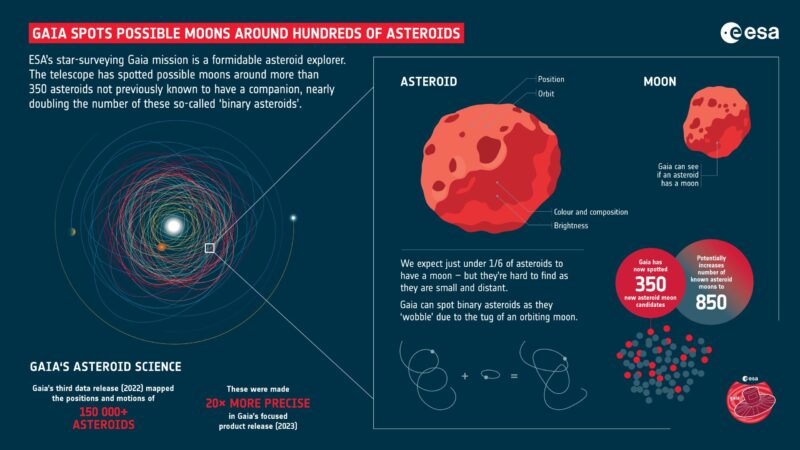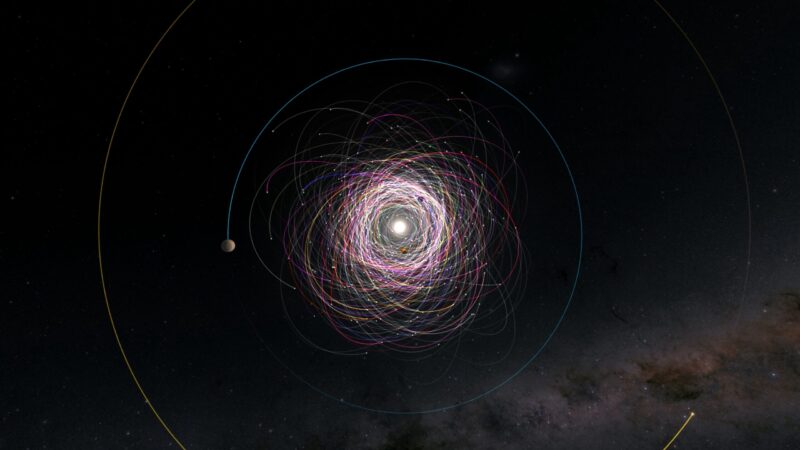
- The Gaia mission’s 3rd data release has revealed the precise orbits of more than 150,000 asteroids.
- Among these, hundreds of asteroids showed a wobble in their orbit that could indicate a possible moon.
- If the moons are confirmed, it would nearly double the number of known binary asteroids.
ESA published this original article on August 8, 2024. Edits by EarthSky.
Gaia spots hundreds of asteroids with possible moons
ESA’s star-surveying Gaia mission has again proven to be a formidable asteroid explorer. It has spotted potential moons around more than 350 asteroids not known to have a companion. Previously, Gaia had explored asteroids known to have moons – so-called binary asteroids – and confirmed that the telltale signs of these tiny moons show up in the telescope’s ultra-accurate astrometric data. But this new finding proves that Gaia can conduct “blind” searches to discover completely new candidates, too.
Luana Liberato of Observatoire de la Côte d’Azur, France, is the lead author of the new study. Liberato said:
Binary asteroids are difficult to find as they are mostly so small and far away from us. Despite us expecting just under 1/6 of asteroids to have a companion, so far we have only found 500 of the millions of known asteroids to be in binary systems. But this discovery shows that there are many asteroid moons out there just waiting to be found.
If confirmed, this new finding adds 352 more binary candidates to the tally, nearly doubling the known number of asteroids with moons.

Asteroid discoveries
Asteroids are fascinating objects. And they hold unique insights into the formation and evolution of the solar system. Binaries are even more exciting, enabling us to study how different bodies form, collide and interact in space.
Thanks to its unique all-sky scanning capabilities, Gaia has made a number of important asteroid discoveries since its launch in 2013.
In its data release 3, Gaia precisely pinpointed the positions and motions of 150,000-plus asteroids. In fact, its observations are so precise that scientists could dig deeper and hunt for asteroids displaying the characteristic “wobble” caused by the tug of an orbiting companion. (It’s the same mechanism as displayed here for a binary star.) Gaia also gathered data on asteroid chemistry, compiling the largest ever collection of asteroid reflectance spectra (light curves that reveal an object’s color and composition).
The 150,000-plus orbits determined in Gaia’s data release 3 were refined and made 20 times more precise. This advancement was part of the mission’s Focused Product Release last year. Astronomers anticipate even more asteroid orbits as part of Gaia’s forthcoming data release 4 (expected not before mid-2026).
Timo Prusti, Project Scientist for Gaia at ESA, said:
Gaia has proven to be an outstanding asteroid explorer and is hard at work revealing the secrets of the cosmos both within and beyond the solar system. This finding highlights how each Gaia data release is a major step up in data quality and demonstrates the amazing new science made possible by the mission.

Hera mission to asteroids
ESA will further explore binary asteroids via the forthcoming Hera mission. Hera is due to launch later this year. Hera will follow up on NASA’s DART mission to produce a post-impact survey of Dimorphos. DART collided with Dimorphos, a moonlet orbiting the asteroid Didymos, in 2022 as an asteroid deflection test. Hera will be the first probe to rendezvous with a binary asteroid system.
Gaia helped astronomers view the shadow cast by Didymos as it passed in front of more distant stars in 2022. This is an observing technique known as stellar occultation.
Gaia’s asteroid orbits and ultra-precise star maps have drastically increased the feasibility of this technique in recent years. And that proves the mission’s immense value for solar system exploration.
Bottom line: The Gaia mission’s 3rd release of data has revealed precise orbits of more than 150,000 asteroids. This has allowed astronomers to look for small wobbles in the asteroids’ orbits, indicating the possible presence of moons.











